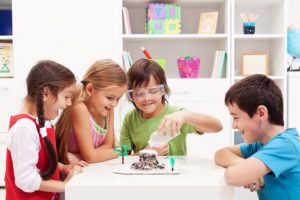
Elementary Winter STEM Explorations

Winter can be an exciting and challenging time for elementary school students. They may be spending less time outdoors and have pent up energy. Luckily, the changes in winter weather offer a variety of engaging STEM activity options for this age group to try out. Here are some ideas for STEM explorations you might want to carry out with elementary school kids this winter:
Create a Weather Station
Some classes may have already created a weather station by this time in the year and if this is the case, winter can be a time to make new and unique observations. If you don’t have a weather station, use the dropping temperatures as an opportunity to introduce meteorology, the study of changes in the air around us.
The main steps to creating a weather station and encouraging your young meteorologists are to lead them to create a weather log, chart, and/or calendar and to help them create (or purchase for them) weather-recording instruments. Using a log, chart, and/or calendar to record weather findings and data teaches youth scientific observation and documentation skills and also helps them to see patterns and invest in the weather center project over time.
Instruments to possibly include in a weather station are a rain/precipitation gauge, thermometer, wind vane, and barometer. While all of these can be purchased, they can be constructed as well–a rain gauge and wind vane are both fairly simple to make. A rain or precipitation gauge can be any clear container with a ruler attached to it or with measurements already written on it. A wind vane can be constructed with a few common materials. Education.com explains how to build one out of: “a round plastic drinking cup with a lid or a round food storage container with lid, pebbles or sand, a sharpened pencil, a drinking straw (a straight one, no bendies!), a straight pin, poster board or card stock paper, black permanent marker, and a compass.” There are directions online for making your own barometer and thermometer as well.
The weather observer or meteorologist can be a rotating special job and all children can also take notes in their own weather journal about what they observe and how the weather influenced their day-to-day lives. An example of an entry might be, “rained today, recess shortened,” or, “low temperatures today, saw ice crystals on the bus.”
 Close-Up Snow Observations
Close-Up Snow Observations
It’s usually not difficult to get elementary aged children interested in snowy weather. Weather permitting, one of the most engaging ways to help them focus closely on winter precipitation is to collect real snowflakes. Geology.com explains that, “a snowflake begins when a tiny dust or pollen particle comes into contact with water vapor high in Earth’s atmosphere. The water vapor coats the tiny particle and freezes into a tiny crystal of ice.” As this new small ice crystal falls, more water vapor freezes onto the main crystal, creating the arms of a snowflake.
To catch some snowflakes, you’ll need to start with a pre-frozen piece of black construction paper or fabric, a magnifying glass, and falling snow. Having the dark surface pre-frozen allows you to view the snowflake for a longer period of time or photograph it.
While snowflakes are each unique, they do all have six arms and are often classified into about 35 types. The temperature and humidity present when a snowflake forms affects its appearance. There’s a helpful guide from Snow Crystals.com that can be used in a snowflake classification or drawing lesson with students. You can also preserve the snowflakes with aerosol hairspray or even make your own Borax Snowflakes. You may also want to introduce your class to the amazing work of snowflake photographers such as the historic Wilson Bentley and modern Don Komarechka.
Teacher Vision also offers an online quiz on different types of snow. For a bit more advanced experiment, classes can measure and compare the density of water, ice, and snow through this project with The University of Chicago’s Department of Astronomy and Astrophysics.
Enjoy Snowy Treats
If you are lucky enough to have snow at your school, edible science cooking projects are also a fun possibility. You can create snow cones or snowy ice cream with your class in a short amount of time. During these projects, kids can work in pairs or small teams and practice measurement and cooperation, which are vital concepts in STEM. Snowy treats are an excellent choice for a reward at the end of a unit on winter or a snack for a parent or family event. To make a snow cone, all you need is fresh, white snow and frozen juice concentrate. Students can add a dollop of the juice into their snow and stir it to create a sweet winter treat.
Snowy ice cream only takes a few minutes to make and is delicious. You will need 4 cans of sweetened condensed milk and 10 cups of snow per can to create 25 servings of snow cream. A sprinkle of sugar and a dash of vanilla extract are popular flavor additions.
There are many other potential winter STEM topics to consider, including the Artic, global warming, and migration. Enjoy your winter STEM explorations!
Written by Julia Travers
Contact us today to learn more about how our tutors can help your child improve their math and science skills!



